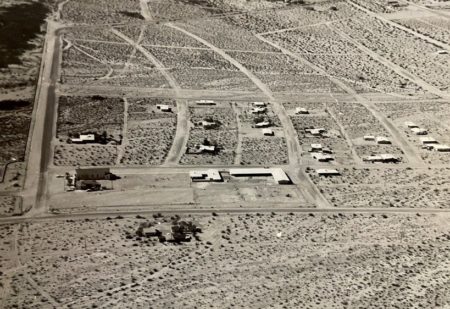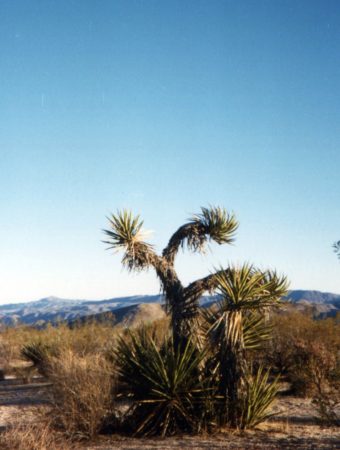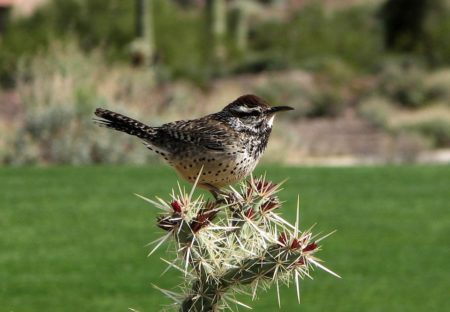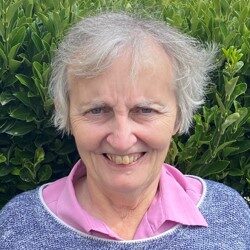The Mojave Desert: with an area of 43,750 square miles, it is about one-third larger than the island of Ireland. The driest desert in the US, it experiences great extremes of heat and cold: Furnace Creek in Death Valley has seen daily temperatures of 134 degrees Fahrenheit (57 degrees Centigrade).
On the edge of the Mojave is the small town of Twentynine Palms CA, where our Sisters lived and ministered for years. For women who didn’t grow up in the desert, it was a strange and wonderful place, full of danger and beauty. These stories show Sisters adapting to desert conditions, learning desert ways, while “nourishing and living the charism of mercy” in a small parish on the edge of a vast and arid landscape.
 Twentynine Palms – (to the forefront) church on left, convent in middle, school on right (photograph courtesy of US Region archives)
Twentynine Palms – (to the forefront) church on left, convent in middle, school on right (photograph courtesy of US Region archives)
Sr. Betty McGovern writes of beginnings:
I was missioned to Twentynine Palms in 1962. Saying goodbye to family and friends in Ireland was heartbreaking, but there was also youthful excitement and enthusiasm about going to a new country, meeting and working with new people and sharing the Gospel message.
The first night in the desert is not easily forgotten. The convent had been vacated from mid-June to mid-August so going inside seemed as if we had stepped into an oven. The newcomers, Catherine and I, were well on the way to discerning that we wouldn’t be able to live there. We felt compelled to write to the Mother General, who clearly told us in writing that it was God’s will that we minister in this location. We spoke to God but God, like the desert, was very silent.
With God’s grace, determination and the wonderful support of the “seasoned” desert Sisters, we hung in there and like them, tried to give it our all. Yet I must confess that the relentless sun and soaring temperatures made life very challenging, as we endured the heat in our traditional black religious habit with all the trappings. The heat, the vast expanse of desert, and occasional furious wind-storms and sand-storms intensified our longing for the “green, green grass of home.”
Many times in the stunning silence of the night the shrill, eerie howl of the coyote wasn’t a welcome sound. It definitely wouldn’t be categorized as a lullaby!
Sr. Catherine Coleman ventures further afield, with alarming consequences:
On weekend trips to the Joshua Tree National Park, we surveyed the giant rock formations, jumbo cactus trees and hidden canyons. Our guide always reminded us, “Keep to the trail.” However, one particular day I decided I would set off to climb some of those huge rocks.
 Joshua Tree National Park (photograph courtesy of Mary O’Connor, US Region)
Joshua Tree National Park (photograph courtesy of Mary O’Connor, US Region)
It all seemed so easy. There was always another peak to climb, another spectacular view, and always an easy way down—or so I hoped. I reached the highest peak and admired the spectacular view of this new Universe. When it was time to return, I jumped down to a ledge but to my surprise I was in an alcove with a sheer drop underneath and no way to climb back up.
Night was falling. Skies turned dark. Only the hungry coyote called out to me. I had to remain still and hope somebody would hear my faint cry. After a few hours standing in the “grotto” I heard two Park Rangers in the distance, and eventually I got down with the assistance of ropes, in my long black robe! Next day the local paper had the headline: “Climbing Nun Rescued.”
Sr. Hilda McDonagh also learns the hard way about living in the desert:
In 1967 I was chosen to go to Twentynine Palms to teach fifth class in Blessed Sacrament School. Shortly after I arrived, the “room mothers” scheduled a field trip for the class to Joshua Tree National Park. A few parents accompanied us. By noon the temperature had already reached 100 degrees; I found it incredibly hot, the sunlight was intense, and there was no shade. Being togged out in a full habit was not exactly helpful. Suddenly, I realized I had forgotten to bring water.
When my lips began to stick together I knew I was dehydrated.
Unlike the foolish virgins, I didn’t ask my companions to give me some of their water. As my condition worsened I was getting very nervous until a parent noticed my dilemma and kindly gave me a small amount of water. I thought I had died and gone to Heaven.
As I recall this rather insignificant experience, I am reminded of the vast number of migrants who die of dehydration as they struggle to cross the desert in search of a better life.
Sr. Betty recalls the destructive power of flash floods, and the helpfulness of Marines:
Flash floods are a feature of desert life. At that time, Twentynine Palms was home to the largest military base in the US. I vividly recall one of the times the Marines came to our rescue. One September, just before school reopened for the new school year and all the classrooms were spick and span, we had a horrendous flash flood. The water rose a few feet high and seeped in to all the classrooms, bringing silt and sand with it.
The captain at the base was alerted, and as soon as the rain eased a team of Marines came on the grounds with tanks, pumps, wet/dry vacuums and dehumidifiers. With military precision they began to work, and after several hours the school building was restored and we could welcome the children back.
Desert Blessings
Sr. Betty goes on: Some of the lifetime desert dwellers have a saying “the desert grows on you” and many of us missioned there found that to be true. There is exquisite beauty in the desert landscape. The clear blue skies, clean air, magnificent sunrises and sunsets and brilliant sunshine are all wonderful and treasured gifts. With the passage of time, we became familiar with the desert animals – roadrunners, scorpions, cactus wrens, jackrabbits, coyotes, desert squirrels, lizards, tarantulas, and many others enjoying their natural environment.
Sr. Catherine concurs: What fascinated me about the desert was its vastness, its unexpected horizons, its clear skies, its barrenness, and in its midst a silence and a serenity.
For my Golden Jubilee, I returned to the Desert. An exceptional display of wildflowers with Saguaro cacti and the Santa Catalina Mountains greeted me when I returned, this time to Tucson, Arizona, for a Thirty-Day Retreat.
Sr. Betty adds: The beauty of the desert certainly included the people. All were very welcoming, hospitable, kind and helpful. Many poets, authors, artists, mystics and others found great solace, peace, contentment and inspiration in the desert. My experience there taught me that silence and solitude are great companions and teachers.
Betty McGovern rsm
Catherine Coleman rsm
Hilda McDonagh rsm



